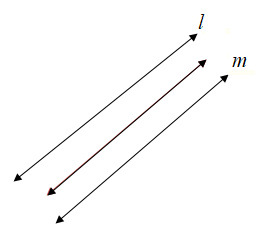
Concept explainers
To draw and describe:
The locus of points in the plane that are equidistant from parallel lines l and m.
Answer to Problem 1CT
Solution:
The locus is in between both lines and is parallel to both.
Explanation of Solution
Definition:
A locus is set of all points and only those points that satisfy a given condition or set of conditions.
In must be noted that, the phrase “all points and only those points” has dual meaning as follows:
1. All points of the locus satisfy the given condition.
2. All points satisfying the given locus conditions are included in the locus.
Calculation:
A locus maintains an equal distance from each line.
Thus, we obtain that the locus must be half way between the two lines. In addition, since it maintains a constant distance, it must be parallel to both.
From this we came to know that the locus equidistant from two parallel lines l and m, is a line parallel to both l and m and halfway between them.

Conclusion:
The path formed by all points the same distance from two parallel lines will be one line halfway between the parallel lines.
Want to see more full solutions like this?
Chapter 7 Solutions
Elementary Geometry for College Students
- Find the area of a square whose diagonal is 10arrow_forwardDecomposition geometry: Mary is making a decorative yard space with dimensions as shaded in green (ΔOAB).Mary would like to cover the yard space with artificial turf (plastic grass-like rug). Mary reasoned that she could draw a rectangle around the figure so that the point O was at a vertex of the rectangle and that points A and B were on sides of the rectangle. Then she reasoned that the three smaller triangles resulting could be subtracted from the area of the rectangle. Mary determined that she would need 28 square meters of artificial turf to cover the green shaded yard space pictured exactly.arrow_forward7. 11 m 12.7 m 14 m S V=B₁+ B2(h) 9.5 m 16 m h+s 2 na 62-19 = 37 +, M h² = Bu-29arrow_forward
- 39 Two sides of one triangle are congruent to two sides of a second triangle, and the included angles are supplementary. The area of one triangle is 41. Can the area of the second triangle be found?arrow_forwardA parallelogram with an area of 211.41 m^2 hast a base Thatcher measures 24.3m. Find ist height.arrow_forwardBH is tangent to circle A and DF is a diameter. I don't know where to go from here. May you help please?arrow_forward
 Elementary Geometry for College StudentsGeometryISBN:9781285195698Author:Daniel C. Alexander, Geralyn M. KoeberleinPublisher:Cengage Learning
Elementary Geometry for College StudentsGeometryISBN:9781285195698Author:Daniel C. Alexander, Geralyn M. KoeberleinPublisher:Cengage Learning Algebra for College StudentsAlgebraISBN:9781285195780Author:Jerome E. Kaufmann, Karen L. SchwittersPublisher:Cengage Learning
Algebra for College StudentsAlgebraISBN:9781285195780Author:Jerome E. Kaufmann, Karen L. SchwittersPublisher:Cengage Learning College Algebra (MindTap Course List)AlgebraISBN:9781305652231Author:R. David Gustafson, Jeff HughesPublisher:Cengage Learning
College Algebra (MindTap Course List)AlgebraISBN:9781305652231Author:R. David Gustafson, Jeff HughesPublisher:Cengage Learning- Algebra & Trigonometry with Analytic GeometryAlgebraISBN:9781133382119Author:SwokowskiPublisher:Cengage
 Algebra and Trigonometry (MindTap Course List)AlgebraISBN:9781305071742Author:James Stewart, Lothar Redlin, Saleem WatsonPublisher:Cengage Learning
Algebra and Trigonometry (MindTap Course List)AlgebraISBN:9781305071742Author:James Stewart, Lothar Redlin, Saleem WatsonPublisher:Cengage Learning Linear Algebra: A Modern IntroductionAlgebraISBN:9781285463247Author:David PoolePublisher:Cengage Learning
Linear Algebra: A Modern IntroductionAlgebraISBN:9781285463247Author:David PoolePublisher:Cengage Learning





